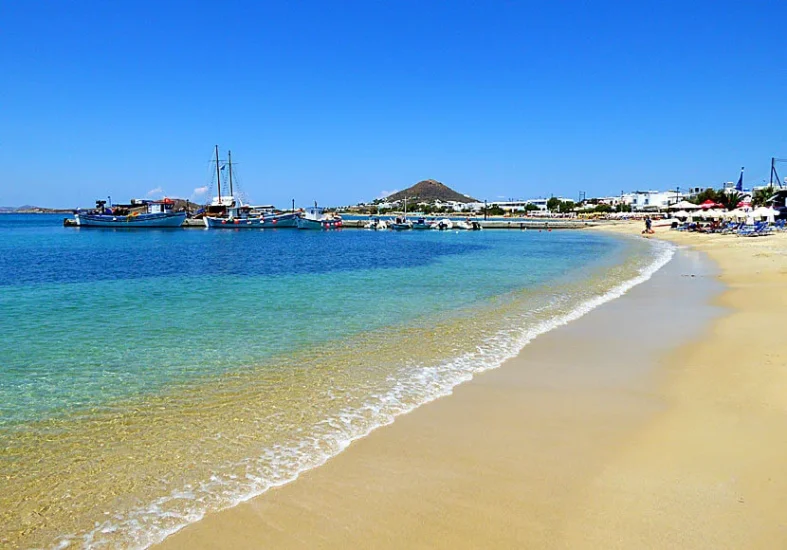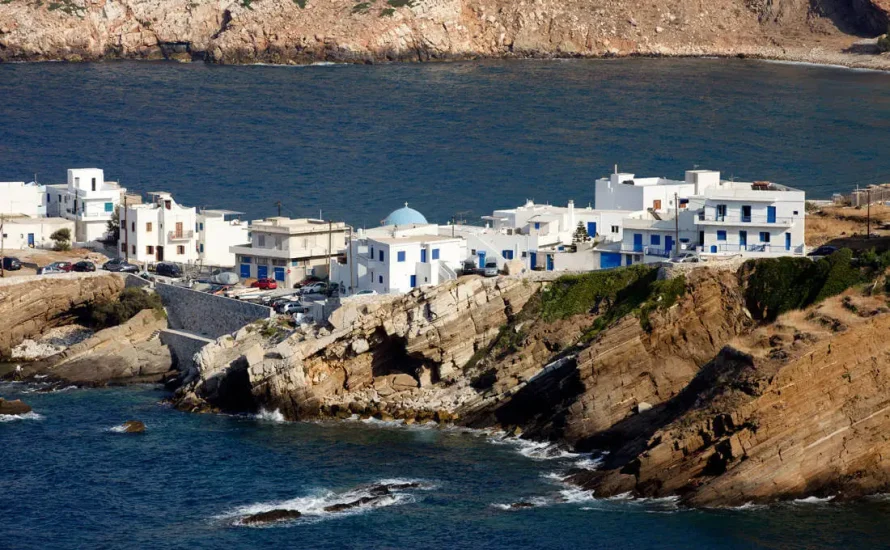Naxos island
Naxos island is the largest and most fertile island of the Cyclades group. It includes an extraordinary landscape, high mountains (mount Zas’ top, reaching 1,004 m, is the highest mountain in Cyclades) and mountainous villages with a singular character. It has an area of 428 sq. km, a coastline of 148 km and a population of 18,000.
In antiquity, the god Dionysus was worshipped on the island. According to mythology, Dionysus met a Minoan lady, Ariadne, who had been abandoned by Theseus in Naxos. From the ancient times to the present day the island has been producing citrus fruits of excellent quality, wine of great quality and very tasty cheese varieties.






1. Naxos Town (Chora)
It is the capital town of the island with characteristic Cycladic culture elements and numerous monuments dating to various historical periods. The heart of the town is beating in Old Chora, the old castle town with cobblestone-laid alleys (kalderimia) and the Venetian castle. The houses with Venetian blazons ornamenting their entrances, the narrow arcaded alleys (called “stegadia”), the catholic churches and the fortifications create a unique blend of Cycladic and Mediaeval architecture.
2. Agios Prokopios
It is a favourite destination among holidaymakers and one of Naxos’ cosmopolitan spots. Enjoy the lovely sandy beach of crystalline seawaters and visit Agios Prokopio’s small church. Distance from Chora: 5.5 km SW.
3. Agia Anna
This is one of Naxos’ most popular resort areas. Its location is on the western side of the island, south of Chora. The sands there are among the top beaches on Naxos. Distance from Chora: 6.5 km SW.
4. Galini
Galini village is on a fertile valley and has been known for the Monastery-Tower of Ypsilotera (1600) built in a unique architectural style. Engares village is situated close by (1 km E), amidst a wooded area with many springs. Distance from Chora: 7 km NE.
5. Melanes
This is yet another beautiful village in a verdant area with numerous streams. Make a point of visiting the colossal 6th century BC statue of Kouros of Melanon, the 17th century Anaktoro Isouiton (Palace of the Jesuits), as well as the Venetian towers of the sovereigns Marco Sanudo, Mavrogenis and Fragkopoulos. Distance from Chora: 7.5 km E.
6. Plaka
Plaka village is located on the western side of Naxos, south of Chora, and is built in a picturesque cove with a beautiful beach. The ruins of the ancient tower in Palaiopyrgos, near the beach of Agios Matthaios, are definitely a site worth visiting. Distance from Chora: 9.5 km S.
7. Sagkri
This village is built in a fertile area and there are three neighbourhoods: Ano Sagkri, Kato Sagkri and Kanakari. Visit the Venetian towers, the traditional windmills and a number of noteworthy Byzantine churches. From Sagkri follow the route towards Agiassos beach (10 km S). Distance from Chora: 11 km SE.
8. Filoti
Filoti is a picturesque mountainous village built on Za’s mountainside, at a 400 m. elevation with cube-shaped little houses and narrow alleys paved with cobblestone, surrounded by lush vegetation. Agiassos wetland – a habitat for many species of flora and fauna- is located nearby. Distance from Chora: 18 km SE.
9. Apeiranthos (Aperanthos)
This is an impressive mountainous large village in the centre of Naxos, one of the island’s most picturesque areas, with houses built of stone, beautiful squares and narrow alleys paved with marble. Locals keep to their customs as well as their dialect. The village boasts a long intellectual and artistic tradition. Distance from Chora: 26 km E.
10. Apollonas
Apollonas is a coastal village, on the northeastern side of Naxos. Along the harbour there are fish restaurants offering a lovely view. Close to the village, at the entrance of an ancient quarry, you will see an unfinished Kouros [statue of a youth] lying on the ground, never eventually having been raised from it. The statue is 10.45 m. long, depicting either Dionysus or Apollo and dating back to the early 6th century BC. The Tower of Agia, situated 7.5 km towards the west, offering a view of the north part of the island, is a sight worth seeing. Distance from Chora: 35.5 km NE.
Quick must see – The 6th century BC Demeter and Apollo sanctuary (on Gyroula hillock), constructed solely of white marble. The worshipping practice was part of Eleusinian Mysteries and the archaeological finds are kept in a museum built in the archaeological site.
Activities in Naxos
1. Swimming in Agios Georgios, at the beaches of Agia Anna, Maragka, in Agiassos and in Roou bay, at Agios Prokopios beach, in Moutsouna, at Apollonas beach, in Amiti, at Kalantou beach, in Pachia Ammos, Chilia Vrysi, Mikra, Kampos, Abram, Agioi Theodoroi, Itona, Kastraki, Glyfada, Liona, in Mikri Vigla, Orkos, Azala, Ligaridia, Psili Ammos, Kleido and in Panormos.
2. Hiking from the church of Agia Marina (near Danakos village) towards the top of Mount Zas, where you will be rewarded by a breathtaking view. A branch of the main trail leads to the northwestern mountainside, where Zas’ cave is located. Try also the route from Apeiranthos to Moutsouna through the emery mines (12 km), from Ano Potamia towards Kato Potamia (2 km) and from Engares towards Kinidaro (6 km).
Useful phone numbers in Naxos
1. Naxos & Minor Cyclades Municipal Office: 22853-60.100
2. Police station: 22850-22.100
3. Rural Health Centre: 22853-60500
4. Port authority: 22850-22.300
5. Airport: 22850-23.292
6. Long Distance Bus Terminus (KTEL): 22850-22.291
7. Archaeological Museum: 22850-22.725
8. Yria Archaeological Collection: 22850-42.325
Country code: +30

What to visit in Naxos island
1. The 17th century tower of Zevgolis.
2. The churches of Panagia Aperathitissa, Agia Paraskevi, at the village’s highest location, and Agios Antonios.
3. Panagia Drosiani’s church and its 7th century murals, dating to the Early Christian Period, at a 5.5 km distance.
4. The four museums of Apeiranthos namely the Archaeological, Geological, Folk Art and Natural History Museum.
5. Panagia Fanariotissa’s country chapel and Agios Pachomios’ church.
6. The old emery mines and the equipment for mineral transportation in Koronos village, located 8.5 km N.





